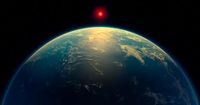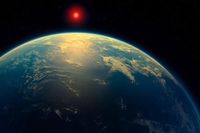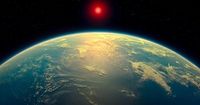On April 17, 2025, a team of scientists from Cambridge University announced a groundbreaking discovery that could change our understanding of life beyond Earth. Using the state-of-the-art James Webb Space Telescope, researchers detected chemical fingerprints of gases in the atmosphere of a distant exoplanet named K2-18b, which is located approximately 124 light-years away in the constellation Leo.
The gases identified, dimethyl sulfide (DMS) and dimethyl disulfide (DMDS), are primarily produced by microbial life on Earth, particularly by marine phytoplankton. This significant finding suggests that K2-18b may be teeming with microbial life, although the researchers were careful to clarify that they are not claiming the discovery of actual living organisms. Instead, they view these gases as a potential biosignature, an indicator of biological processes occurring on the planet.
Professor Nikku Madhusudhan, the lead author of the study published in the Astrophysical Journal Letters, described this moment as a "transformational moment in the search for life beyond the solar system." He emphasized that this discovery demonstrates the capability to detect biosignatures on potentially habitable planets using current technology. "We have entered the era of observational astrobiology," Madhusudhan stated.
K2-18b, which is 8.6 times the size of Earth and has a diameter about 2.6 times larger than our planet, orbits within the "habitable zone" of a red dwarf star, where conditions may allow for liquid water to exist—a key ingredient for life. The researchers noted that earlier observations from the James Webb Space Telescope had already identified methane and carbon dioxide in the planet's atmosphere, marking the first time carbon-based molecules were discovered in the atmosphere of an exoplanet within a star's habitable zone.
The detection of DMS and DMDS was made at atmospheric concentrations exceeding 10 parts per million by volume, with a confidence level of 99.7%. This high confidence suggests that the presence of these gases cannot be easily explained by non-biological processes. Madhusudhan remarked, "For reference, this is thousands of times higher than their concentrations in the Earth's atmosphere and cannot be explained without biological activity based on existing knowledge."
However, despite the excitement surrounding this discovery, scientists involved in the research are urging caution. Madhusudhan stressed the need for further observations to confirm the findings and to rule out other possible abiotic mechanisms that could produce DMS or DMDS in the atmosphere of K2-18b. He stated, "First, we need to repeat the observations two to three times to ensure the signal we are seeing is robust and to increase the detection significance to a level where the odds of a statistical fluke are below roughly one in a million."
Christopher Glein, a principal scientist at the Space Science Division of the Southwest Research Institute in Texas, echoed Madhusudhan's sentiments, stating, "The rich data from K2-18b make it a tantalizing world. Yet, we must be very careful to test the data as thoroughly as possible. I look forward to seeing additional, independent work on the data analysis starting as soon as next week."
The findings from K2-18b add to the growing body of knowledge about exoplanets, with over 5,800 such planets identified since the 1990s. Madhusudhan referred to K2-18b as a member of the "sub-Neptune" class of planets, characterized by a diameter greater than Earth's but smaller than Neptune, the smallest gas planet in our solar system.
While K2-18b's potential to host life captivates the imagination, the scientific community remains cautious. Madhusudhan expressed hope that humanity is on the brink of answering the age-old question of whether we are alone in the universe. He remarked, "Decades from now, we may look back at this point in time and recognize it was when the living universe came within reach."
In addition to the revelations about K2-18b, NASA's Curiosity rover recently made headlines by discovering the largest organic compounds ever found on Mars, located within a 3.7 billion-year-old rock that may have once been part of a freshwater lake. This discovery further fuels the ongoing quest to find evidence of life beyond our planet.
As research continues, the possibility of alien life remains a driving force for scientists determined to uncover the mysteries of the universe. The findings from K2-18b represent a significant step forward in this endeavor, illuminating the potential for life on distant worlds.



